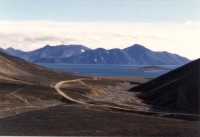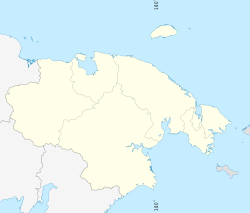Novoye Chaplino
| Novoye Chaplino (in English) Новое Чаплино (Russian) |
|
|---|---|
| - Rural locality - Selo |
|
 Road to Novoye Chaplino |
|
 Location of Chukotka Autonomous Okrug in Russia |
|
|
|
|
|
|
|
| Administrative status (as of October 2010) | |
| Country | Russia |
| Federal subject | Chukotka Autonomous Okrug |
| Administrative district | Providensky District |
| Municipal status (as of October 2010) | |
| Municipal district | Providensky Municipal District |
| Urban settlement | Provideniya Urban Settlement |
| Statistics | |
| Population (2010 Census) | 419 inhabitants |
| Population (January 2016 est.) | 362 inhabitants |
| Time zone | PETT (UTC+12:00) |
| Postal code(s) | 689272 |
| Dialing code(s) | +7 42735 |
Novoye Chaplino (Russian: Новое Чаплино) is a village (selo) in Providensky District of Chukotka Autonomous Okrug, in the Far Eastern Federal District of Russia. Population: 419 (2010 Census); Municipally, Novoye Chaplino is subordinated to Providensky Municipal District. In 2010, a law was passed abolishing the municipal rural settlement of Novoye Chaplino. The village continues to exist, but is now municipally part of Providenia Urban Settlement.
The village was founded in 1960, although some sources state that it was founded in 1958 as a result of the merging of several nearby coastal villages into one. Villages such as Unazik (lit "Bewhiskered" in Yupik and formerly an important local whaling centre), Chechen, Kivak (lit. "Green Glade" in Yupik and the site of an ancient settlement several thousand years old) and Plover, as well as settlements from much further up the coast such as the now abandoned village of Naukan.
Novoye Chaplino is a good example of how following the collapse of the Soviet Union, the outflow of Russian migrants allowed indigenous people to take up senior administrative posts in the local administration. In a similar situation to other Chukotkan villages such as Markovo, During Soviet times, about 25% of the population of the village were non-indigenous in-comers. Despite being in the minority, they formed the majority of senior employees in areas such as the state farm, village administration and technical services. In-comers also dominated senior positions at the school including the principal, boarding-school supervisore, administrative director, bookkeeper and 11 out of the 18 licensed teachers.
Following the collapse of the Soviet Union, indigenous people managed to gain more influence in their key local services. By 1995, in-comer departure was almost complete. Whereas over 110 people out of a population of 460 were non-indigenous in 1986, barely 30 remained nine years later, and those were mostly married to indigenous villagers. Although the economic situation meant that a number of local industries had closed or had truncated staff numbers, in the state farm, three quarters of the top officials were indigenous people and over two thirds (of the admittedly smaller) school were either Chukchi or Yupik.
...
Wikipedia

